Hello, travelers! I’m Michael Zhang, a seasoned travel enthusiast from China with extensive international experience. I have a deep passion for exploring historical landmarks and uncovering cultural treasures. Today, I’m thrilled to introduce you to Longhua Temple, a historic and spiritual gem nestled in the vibrant city of Shanghai. Whether you’re a history buff, a devoted pilgrim, or someone seeking tranquility amid urban chaos, Longhua Temple promises to captivate you. Let’s dive into the temple’s fascinating history, iconic landmarks, and hidden gems to help you make the most of your visit!
Summary
Introduction to Longhua Temple
Longhua Temple, located in Longhua Town, Xuhui District, is the largest and oldest Buddhist temple in Shanghai. Spanning over 20,000 square meters with a 5219-square-meter building area, the temple is laid out along a central axis. Visitors can explore its six grand halls, including the Maitreya Hall, Heavenly Kings Hall, Grand Hall of the Great Sage, Three Saints Hall, Abbot’s Room, and Sutra Library.
- Address: 2853 Longhua Road, Longhua Town, Xuhui District, Shanghai (Apple Maps/Amap)
- Opening Hours: 7:00 AM to 4:30 PM year-round; during incense periods (lunar 1st and 15th): 6:00 AM to 4:30 PM
- Recommended Visit Time: 2–3 hours
- Best Season to Visit: All year round
- Admission Fee: Free
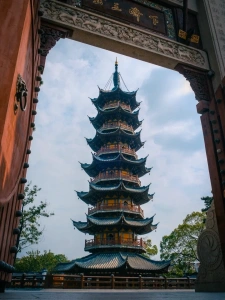
Map of Longhua Temple
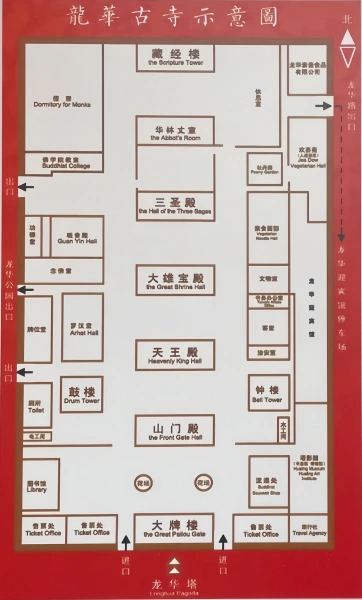
The Origins of Longhua Temple’s Name
The name Longhua Temple originates from Buddhist scriptures, referencing Maitreya Bodhisattva’s enlightenment beneath the Longhua Tree. According to legend, the temple was first built during the Three Kingdoms period by Emperor Sun Quan for his mother. While the temple has a history of over 1,700 years, documented records date its construction to 977 AD during the Northern Song Dynasty.
In 1066, it was renamed “Kongxiang Temple,” and remnants of the bestowed nameplate and stele still exist today. During the Ming Dynasty (1403–1424), the temple’s original name, Longhua Temple, was restored. In 1574, it was granted the formal title “Daxingguo Wanshou Cihua Chan Temple,” though the name Longhua Temple remains widely used.
Why You Should Visit Longhua Temple
A Rich Historical Legacy
With a history of over 1,700 years, Longhua Temple is not only the oldest but also the largest Buddhist temple in Shanghai. It has undergone multiple reconstructions due to natural and human-caused damage. The current architecture mainly dates back to the Guangxu reign of the Qing Dynasty. The temple serves as a significant cultural and historical site in addition to being a Buddhist sanctuary.
Historical Significance and Cultural Value
Originally built by Emperor Sun Quan during the Eastern Han Dynasty, Longhua Temple has witnessed numerous dynastic changes, retaining its importance as a center for Buddhist worship. The temple’s name and history are deeply tied to the Buddhist tale of Maitreya Bodhisattva, enhancing its spiritual and cultural significance. Today, it is recognized as a national heritage site in China.
Spiritual Blessings and Visitor Experiences
Longhua Temple is renowned for its efficacy in granting wishes, especially concerning academic success, career advancement, and personal growth. Many visitors attest to their prayers being answered, making the temple a sanctuary for peace and hope. Additionally, its serene surroundings, featuring lush greenery, courtyards, wells, and the iconic pagoda, provide a tranquil escape. Don’t miss the temple’s vegetarian offerings, including its highly rated noodle dishes, which are both delicious and budget-friendly.
Things to Do in Longhua Temple
Main Attractions
Longhua Pagoda
The iconic Longhua Pagoda, constructed in 977 AD during the Song Dynasty, is a stunning seven-tiered octagonal wooden tower reaching a height of approximately 41 meters. Its interior features a brick core with small square rooms, while the exterior includes wooden corridors showcasing the hallmarks of Song Dynasty architecture.
Notably, the pagoda’s design incorporates a unique structure where the orientation of the square rooms alternates by 45 degrees at each level. This innovation balances the distribution of weight and creates an aesthetically pleasing, staggered appearance. Other notable architectural elements include intricate brickwork, cross-shaped brackets, and symbolic carvings, making the Longhua Pagoda a masterpiece of ancient Chinese engineering.
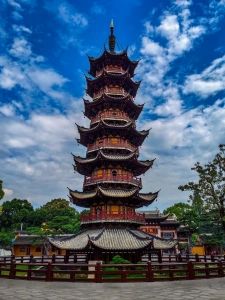
The Temple Gate
The main gate of Longhua Temple is a grand entrance that sets the tone for the sacred experience awaiting visitors. At the center of the gate, you’ll find a plaque inscribed with the characters “Longhua” in an elegant clerical script. Above the plaque, there is a large imperial seal bearing the inscription “The Treasure Seal of Longhua Lecture Hall Granted by the Emperor,” a significant artifact of the temple’s legacy. Interestingly, this “seal” is actually made of jade, but due to its imperial origins, it is referred to as a “golden seal.”
On either side of the gate, plaques read “Ancient Temple of Jiangnan” and “Dusita of the Mortal World.” These inscriptions highlight Longhua Temple’s status as one of the oldest temples in the Jiangnan region.
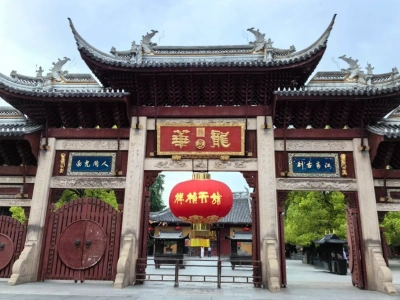
Maitreya Hall
Unlike most temples where the first hall is the Heavenly Kings Hall, Longhua Temple begins with the Maitreya Hall. This distinction underscores its unique architectural style. Hanging from the eaves is a plaque inscribed with “Longhua Temple” by the revered Buddhist leader and master calligrapher Zhao Puchu.
Flanking the entrance, two stone lions stand guard. The male lion on the left has a ball under its paw, symbolizing unity, while the female lion on the right steps on a cub, representing prosperity and lineage. These sculptures, known as the “Three Kings Lions,” feature intricate carvings of peonies, phoenixes, and lions on their bases, signifying their supreme status.
Inside, the hall houses a magnificent brick carving of “Nine Lions,” symbolizing the mission to “save the world.” At the center stands the jovial and rotund Budai Monk, the smiling incarnation of Maitreya Bodhisattva.
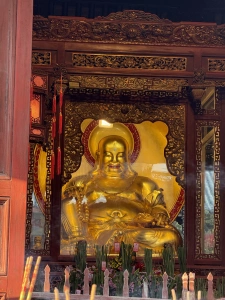
Heavenly Kings Hall
Directly behind the Maitreya Hall is the Heavenly Kings Hall, where the crowned statue of Maitreya Buddha in formal attire takes center stage. Flanking the Buddha are statues of the Four Heavenly Kings, each embodying a protective force. Behind Maitreya Buddha is the deity Wei Tuo, standing guard and facing the Grand Hall of the Great Sage.
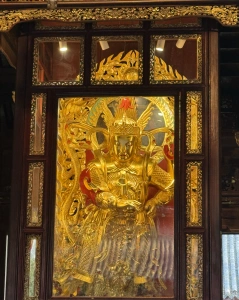
Grand Hall of the Great Sage
The Grand Hall, also known as the Mahavira Hall, is one of the most significant parts of Longhua Temple. Its double-eaved roof and intricate ridge decorations epitomize traditional Chinese architectural elegance. Inside, the central statue is of Vairocana Buddha, adorned with a sacred crown and hand gestures symbolizing enlightenment.
Flanking Vairocana Buddha are Manjushri on the left and Samantabhadra on the right, both revered for their wisdom and virtue. The hall also features the Twenty Heavenly Kings, the Eighteen Arhats, and a depiction of the historical Buddha’s profound teachings at Vulture Peak, where disciples and deities gathered to hear his wisdom.
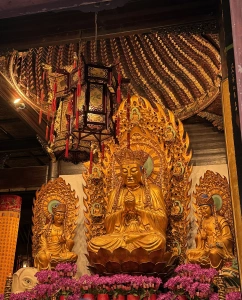
Guanyin Hall
To the west of the Three Saints Hall lies the Guanyin Hall, dedicated to the compassionate Guanyin Bodhisattva. The hall showcases a diverse collection of statues, including the Thousand-Armed Guanyin, thirty-two transformative figures of Guanyin, and representations of major celestial, human, and mythical figures such as Mahadeva, King Prasenajit, and the Eight Kinds of Ghosts.
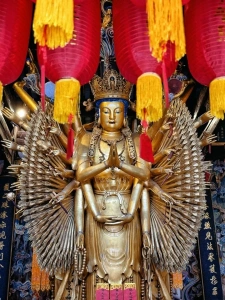
Longhua Temple Ticket Guide
Ticket Prices
- Admission: Free, no reservation required.
- Incense Offering: 20 RMB for 3 sticks.
Guide to Visiting Longhua Temple
Longhua Temple does not require professional tour guides, as it is relatively compact with a well-organized layout. Visitors can explore the temple independently by following the clear signage and descriptions at each hall. The primary experience revolves around incense offerings and soaking in the serene atmosphere. Each hall provides ample historical and cultural context, making it easy for visitors to understand the temple’s rich heritage.
How to Offer Incense at Longhua Temple
- Enter through the South Gate (main entrance). On the right-hand side, purchase incense: 20 RMB for three large sticks or 3 RMB for a bundle of smaller ones.
- Hold the incense with both hands, make a wish silently, and walk clockwise around Longhua Pagoda three times.
- After completing the walk, light the incense, bow in all four directions clockwise, and place the incense in the censer.
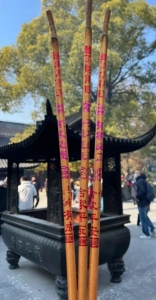
Buddhist Activities at Longhua Temple
New Year’s Eve Bell Ringing
Since 1991, Longhua Temple has hosted the New Year’s Eve Bell Ringing Ceremony every December 31st. This event attracts both domestic and international visitors and has been designated as a national-level tourism activity by the China National Tourism Administration.
- Admission: 100 RMB
- Bell Ringing Fee: 200 RMB
Longhua Temple Fair
Every spring, typically in March or April, Longhua Temple holds its lively Temple Fair, inspired by the old saying, “On the third day of the third lunar month, visit Longhua and see the peach blossoms.” This festival honors the Bodhisattva Maitreya’s incarnation as the Budai Monk. During this time, the temple hosts commemorative rituals, bustling market stalls, and cultural performances such as dragon and lion dances, traditional crafts, and local snacks.
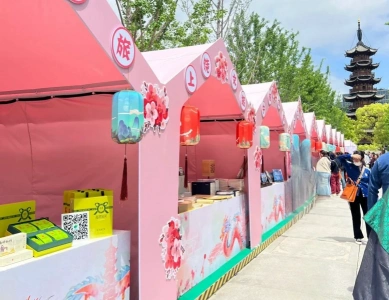
Temple Ceremonies
Longhua Temple conducts regular Buddhist ceremonies almost every month, lasting 1–2 days each. Notable events include the Ullambana Festival on the 15th day of the seventh lunar month. If you visit during a ceremony, participating is highly recommended for a deeper cultural experience.
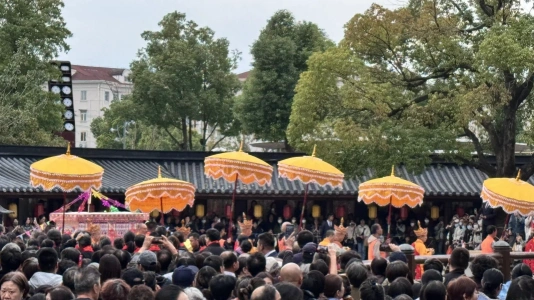
How to Get to Longhua Temple from Downtown Shanghai
By Metro
- Take Line 11 or Line 12 of the metro, get off at Longhua Station, exit from Exit 4, and walk for 5 minutes to reach Longhua Temple.
- Take Line 3 of the metro, get off at Longcao Road Station, exit from Exit 3, and walk about 10 minutes to reach Longhua Temple.
- Transportation Card Purchase: Trip.com Discounts, Klook Deals, KKday Offers
By Bus
Several bus lines, including 41, 44, 73, 87, and 104, provide direct access to Longhua Temple.
- Transportation Card Purchase: Trip.com Discounts, Klook Deals, KKday Offers
By Taxi or Rideshare
A taxi or rideshare from downtown Shanghai to Longhua Temple takes approximately 20–30 minutes, with an estimated fare of 30 RMB.
Recommended Vegetarian Noodles Near Longhua Temple
For vegetarian food enthusiasts, Longhua Temple offers its signature vegetarian noodles, a favorite among visitors. Both the noodles and toppings can be refilled at no extra cost.
- Location: Inside the temple, at the farthest end.
- Price: Luohan Noodles – 15 RMB.
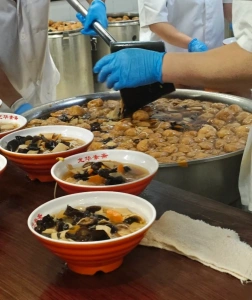
FAQ
Is Longhua Temple Suitable for Strollers?
Due to the stone-paved pathways and several staircases within the temple, strollers may not be convenient. It’s recommended to use a baby carrier for a smoother visit.
Where Can I Store Luggage?
Although Longhua Temple does not have official luggage storage facilities, a storage service is available about 200 meters from the temple’s entrance, near Exit 3 of Longhua Metro Station. The service operates between 8:00 AM and 9:00 PM.
Essential Shanghai Travel Resources
- Comprehensive Shanghai Travel Guide 📖
- Shanghai Travel Recommendations 🏙️
- Hotel Recommendations 🏨
- Transportation Guides ✈️ 🚇 🚄 🚆
- Essential Travel Tips and Tools 🗺️ 🍜 📱 💸 🌤️ 💊🛍️🔌📶🧳

 English (US)
English (US)  English (Hong Kong)
English (Hong Kong)  English (Malaysia)
English (Malaysia)  English (Singapore)
English (Singapore)  繁體中文
繁體中文 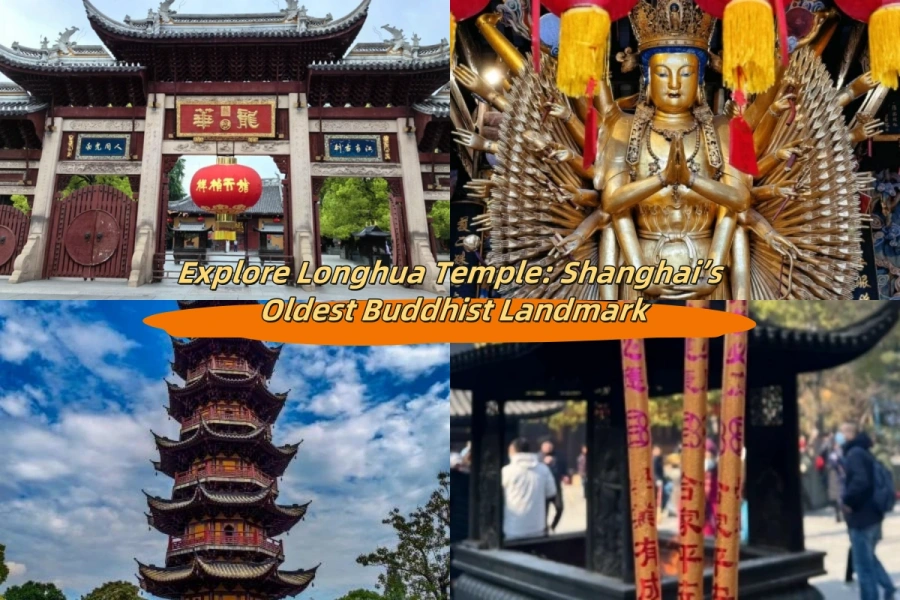
Comment (0)